|
THE DUTCH AT
THE CAPE |
|
The flags of the
Netherlands had a great influence on those later used by the
Boers. Though by 1660 the orange-white-blue Princevlag
(Prince's Flag) was beginning to give way to the red-white-blue
Driekleur
Vlag (Three-Color Flag), its memory influenced the design of
the 1928 South African national flag. (Evidently, red replaced
orange because the dyestuffs used to make Dutch flags in the
late seventeenth century produced a color closer to red than
orange.) Dutch maritime flags of the period were often made with
the basic three-stripe pattern repeated, as in the example below
(the tricolor pattern repeated twice, separated by a white
stripe). Besides the plain Dutch tricolor, a variant with
the monogram of the Dutch East Indies Company may also have been
used at the Cape of Good Hope settlement. The small 'C" was for
the Cape of Good Hope. |
|
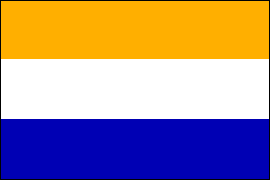
Princevlag |
|
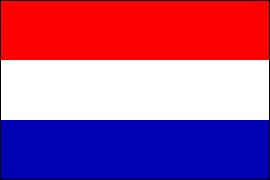
Driekleur Vlag
|
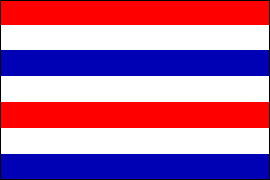
Driekleur Vlag
• Variant |
|
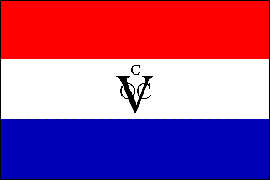
Vereenigde Oostindische Compagnie
Vlag
|
|
VOORTREKKER
SETTLEMENTS & BOER FREEBOOTER REPUBLICS |
|
The Voortrekker
Boers established a number of settlements and republics in the
years following their migration out of the Cape Colony. The
first flag that can be characterized as the banner of a Boer
republic is the
Voortrekker Vlag, blue
with a red saltire cross. Also known as the
Potgieter Vlag
after General A.H. Potgieter, a leader of the migration, it is
known to have been used from the early 1830s to about 1840, and
in a slightly modified form it was the flag of
Potchefstroom
(founded 1838), the town that later became the first capital of
the
Zuid-Afrikaansche Republiek
(South African Republic, also known as the Transvaal Republic). The Dutch colors (red, white and
blue) figured in most of these flags. From the late 1830s to the 1880s, a
spate of Boer mini-republics sprang into being. Some, like
Natalia, were
annexed by Britain; others. like the
Klein
Vrystaat
(Little Free State) were eventually incorporated into the
Zuid-Afrikaansche Republiek. |
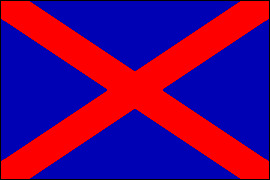
Voortrekker
Vlag |
|
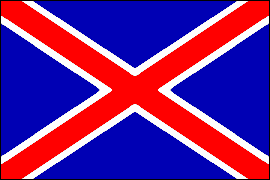
Potchefstroom
• 1838-52 |
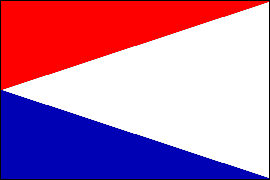
Natalia
• 1838-43 |
|
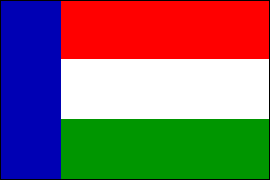
Nieuwe
Republiek • 1881-84 |
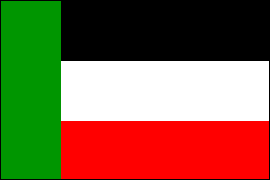
Goshen • 1884-85 |
|
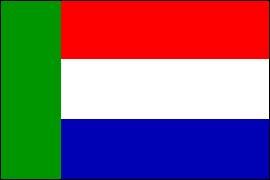
Klein Vrystaat
• 1886-91
|
|
THE SOUTH AFRICAN
REPUBLIC & THE ORANGE FREE STATE |
|
When the
Zuid-Afrikaansche Republiek
(South African Republic) was formed in 1852 it had no official national
flag, though probably the Voortrekker Vlag and its
variant, the flag of the town of
Potchefstroom,
were in common use. Finally, in 1858, the
Volksraad
(Parliament)
passed a law establishing a national flag. Designed by Reverend
Dirk van der Hoff, originally for the
Klein
Vrystaat, it combined the horizontal red, white and
blue stripes of the Dutch flag with a vertical green stripe at
the hoist, thus symbolizing the Republic's African locale and
its fraternal ties to the Netherlands. This flag, called the
Vierkleur ("four colors") remained in use (with one brief
intermission) until 1902, when defeat in the Anglo-Boer War
brought an end to the Republic. In 1874, on the initiative of
President Burgers, the old flag of
Potchefstroom was
made the national flag. Burgers disliked the
Vierkleur and
felt that the
Potchefstroom
flag, which was based on the
Voortrekker Vlag,
was a more appropriate banner for a Boer republic. Few people
shared his opinion, however, and the Volksraad restored
the Vierkleur in 1875—reportedly while President Burgers
was absent on a visit to Europe! Perhaps as a sop to Burgers,
the
Potchefstroom flag was made the presidential flag. But it
remained unpopular and soon fell into disuse. |

Zuid-Afrikaansche Republiek •
National Flag 1858-74 &
1875-1902 |

Zuid-Afrikaansche Republiek •
National Flag 1874-75 |
|
Like the South
African Republic, the
Oranje Vrijstaat
(Orange Free State, established in 1854) at
first had no official national flag. To remedy this situation,
the Free State government petitioned King William III of the
Netherlands for a grant of arms and a flag. The King agreed to
this request and in 1856 his envoy arrived in the Free State's
capital, Bloemfontein, to make the official presentation. The
flag consisted of seven horizontal stripes, white and orange,
with the Dutch flag as a canton. This design symbolized the Free
State's name, its fraternal ties to the Netherlands, and the
monarch of the House of Orange in whose name the flag was
granted. It remained unchanged until 1902 when defeat in the
Anglo-Boer War brought an end to the Free State. |
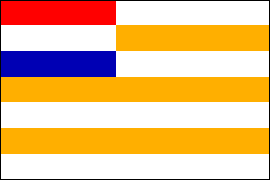
Oranje Vrijstaat
•
National Flag • 1856-1902 |
|
THE ANGLO-BOER WAR |
|
Though the
Zuid-Afrikaansche Republiek
and the Oranje Vrijstaat
had not always enjoyed amicable relations, they made common
cause against the British during the Anglo-Boer War
(1898-1902). Their alliance was symbolically expressed by the
various flags that were used by the Boer forces during the war.
Most were variants of the
Vierkleur Vlag with orange added, thus combining the colors
of both Boer republics. |
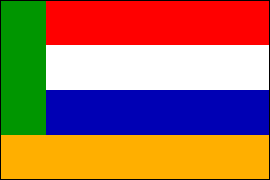 |
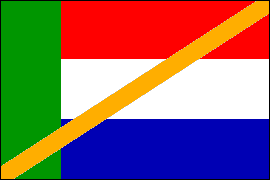 |
|
Boer "Unity" Flags
• 1898-1902 |
APARTHEID SOUTH
AFRICA |
|
When the various
British colonies in southern Africa were united in 1910 to form
the Union of South Africa, its official national flag was the
Union Jack and the de facto national flag was the South
African Red Ensign. This situation did not suit the Boers and in
1928 South Africa adopted as its national flag a horizontal
tricolor of orange, white and blue—a variant of the old Dutch
Princevlag (Prince's Flag). On the white stripe was a badge
combining the Union Jack and the flags of the former Boer
republics. The design was in fact a compromise that did not
entirely satisfy anyone. South Africans of British origin
opposed the abandonment of the Union Jack, while the Boers
wanted to expunge all reminders of the hated British connection. Though there were various proposals to replace it
in later years the 1928 flag was not changed, even when South
Africa became a republic in 1962. It was abolished in 1994 when
the apartheid regime came to an end. |
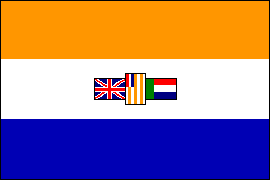
National Flag
• 1928-94 |
|
THE
BOERS IN
POST-APARTHEID SOUTH AFRICA |
|
With the end of the
apartheid regime in 1994, the "white tribe" lost its dominant
political and social position. This was reflected in the
replacement of traditional national symbols, including flags and
coats of arms, with new ones that did not recall the dark days
of apartheid. The Boers, however, continue to display their
traditional flags, particularly those of the former republics
and variants thereof. A typical example of a variant flag is
that of the
Afrikaner Volksfront
(Afrikaner People's Front), which is similar to the
Vierkleur but with orange in place of red. Other
contemporary Boer flags are frankly fascist in inspiration, such
as those of the Boere Weerstandsbeweging (Boer Resistance
Movement) and the Afrikaner Studentebond (Afrikaner
Student Federation). Many of these Afrikaner political
organizations advocate the creation of a separate homeland for
the Boers. |
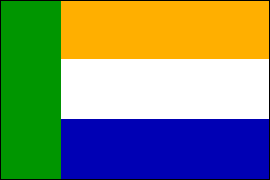
Afrikaner Volksfront
|
|
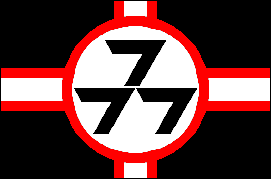
Boere
Weerstandsbeweging
|
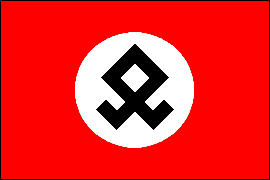
Afrikaner
Studentebond
|















